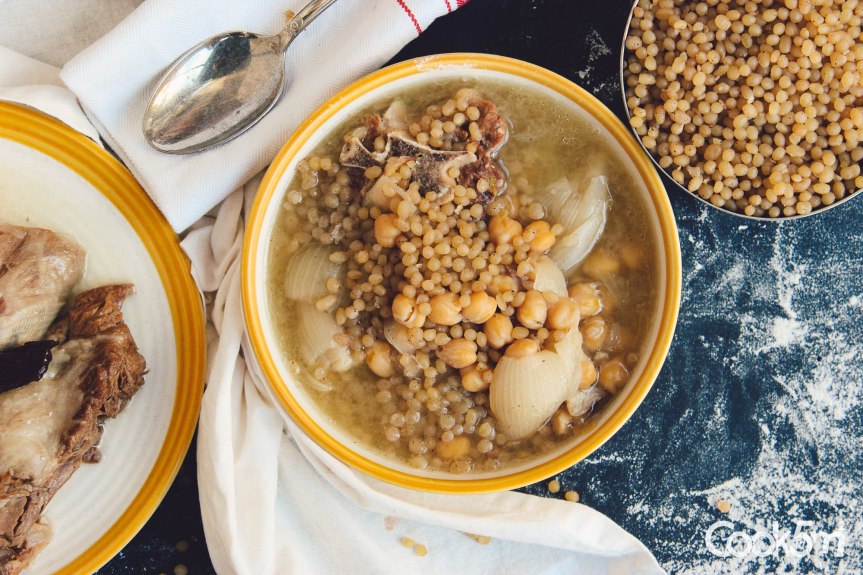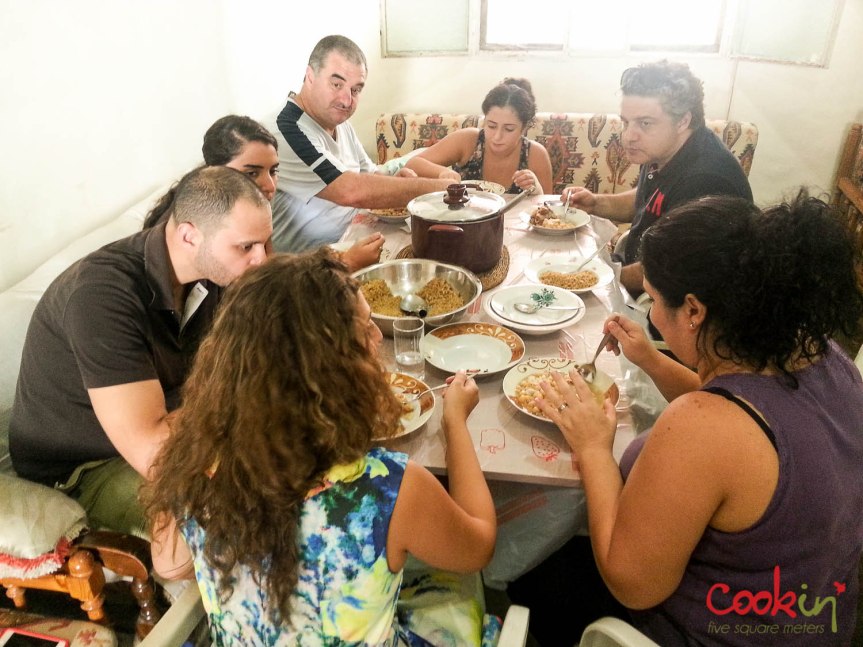
I’ve been searching for the origin of this recipe. I was asking people around me how they (or their grandparents) heard of this particular dish. My question was where did they get the recipe from and how did they make the pearls/giant couscous/maftoul (as we call it) or get them from. Almost no one could give me a satisfying answer about its origin. All they know is that they used to get the “maftoul” from the supermarket and no idea how the recipe got to them..
Up until I saw the origin of moghrabieh on Dirty Kitchen Secrets, I used to think it was a Palestinian dish. Turns out it is Moroccan. Due to its origin, this dish gained the name that was altered I guess with time and accents from maghribiyah (from Morocco) to Moghrabieh. This is how Wikipedia defines it: “It was brought by Moroccan migrants to Palestine, where it has been modified to what’s called maftoul. Although maftoul is considered as a special type of couscous but made from different ingredients and a different shape. Maftoul is an Arabic word derived from the root “fa-ta-la” which means to roll or to twist, which is exactly describing the used method to make maftoul by hand rolling bulgur with wheat flour.”


What I know, for sure, is that making maftoul is a Palestinian tradition that few know about and still do to this day. I remember the time when my grandmother used to make maftoul for the huge moghrabieh pot we cook. Mom and grandma (her mother-in-law) used to sit next to low tables with wide round shallow pots and roll the cracked wheat for hours with flour, yeast, water and oil till they get satisfactory pearls. They used to keep us busy while they work by giving us a pot with the ingredients and ask us to roll some. It was fun getting messy with our hands.

Unlike the market moghrabieh, these fresh ones are more delicious and fragrant. I would allow myself to declare that you have not tasted real moghrabieh until you have tried this particular one.
Moghrabieh is not an everyday dish in our family. Whenever there is moghrabieh, there has to be, at least, 7 persons at lunch. It takes time to prepare but the end result is a homogeneous mix of flavors declaring itself in the earthy crumbly texture of maftoul and the rich stew that bursts with essence of meat and bones caressing your palette with onions, chickpeas, and melange of fragrant spices. Yes, meat and bones. The best way to cook it (but not particularly the way I like it) is with lamb meat and bones. The fattier the meat is, the better the stew.
Not for me though.

I used to have it with chicken (back when I stopped eating meat for 2 years) but it doesn’t even come close to the original recipe.
For this special Sunday lunch, we had special guests over. Apart from my family, we had Chef Tommy, whom I met at Food Blogger Connect Lebanon and promised to share this family recipe with, my amazing friend NaNo before leaving to UAE, and Mike who’s almost part of the family now. We had a live demonstration of how maftoul is made before digging in what Chef Tommy described as no other moghrabieh he has had before can compare to this.



Moghrabieh (+ how to make Maftoul)
For 10 persons
Ingredients
Maftoul
- 1 cup partially cracked wheat (rinsed)
- Careful, this is not burghul. It is wheat that is cracked once. You can still figure out the shape of the grain.
- 1.5 kg Flour
- 1 tbsp Yeast
- ½ tsp salt
- ¾ cups Olive oil
- 1.5 cups Water
- Seasoning
- 20 gm Butter
- ½ tsp Salt
- 1 tsp Ground cinnamon
- ¼ tsp Ground nutmeg
- 1 tsp Caraway
Moghrabieh stew
- 2 kg Lamb meat (with bones)
- 2 kg Small onions (peeled)
- 1 kg Chickpeas (soaked and boiled)
- 3 Cinnamon sticks
- 7-8 Cardamom
- 1 Whole nutmeg (cut in half)
- 4-5 Cloves
- 2 Bay leaves
- Salt
Procedure
- In a bowl, mix the water, oil, yeast and salt.
- In a large shallow pot, place the rinsed and dried cracked wheat.
- Drizzle a tablespoon of the liquid mixture over the cracked wheat and roll in the pot applying gentle pressure.
- Sprinkle a handful on flour over the wheat and roll again with gentle pressure.
- Repeat alternating between the liquid mixture and flour whenever you feel the added element is absorbed by the wheat.
- The flour will start to add up on top of the wheat creating small pearls. Keep going until you reach the desired size.
- Remember, it is a time-consuming process but, like everything that you put a lot of effort in, it is worth it.
- You can make them the night before and lay them covered with a plastic sheet overnight or make them in the morning and set them aside till it’s time to cook them.
- Boil a large pot of water
- When the water boils, add the meat and bones
- Boil and skim the froth
- Add onions and the spices and boil
- Reduce the heat and simmer for at least an hour
- Drop the cooked chickpeas carefully into the boiling pot and keep simmering for another hour
- In the meantime, we have to steam the maftoul
- Toss maftoul in olive oil and wipe a colander or a steamer (that fits perfectly over the top of the pot)
- Place the maftoul in oiled colander over the boiling stew making sure the bottom of the colander doesn’t touch the stew
- Cover with a cloth (because it will absorb the vapour instead of dropping it back on the maftoul pearls) and the lid (if available, or needed) and steam for 30 minutes stirring occasionally with a skewer to avoid messing up with the texture
- Taste and check that they’re done
- Remove and toss well with butter and spice
- By this time, the stew should be ready
- Scoop in serving bowl

For serving, add a large spoon of maftoul and top with stew and enjoy.
This hearty meal is good on its own.
Do not attempt to make any starters or salad. You’ll mess things up.
Desserts are also not advisable, unless after a few hours, or maybe at night.
For more details, check the Flickr set (http://www.flickr.com/photos/hishamad/sets/72157637863976293/)
and the YouTube video: http://www.youtube.com/watch?v=3C5qAsntCTA
And check these vines made on that day:
[UPDATE]
Recently, Anthony from NoGarlicNoOnions discovered Moghrabieh as street food and in a sandwich in Tripoli (our Lebanese Tripoli that is) and now I’m curious to tasting it myself.

LOVE the POST 😀
Good JOB
LikeLike
Thank you Maya
Would be great if you’d share it too 🙂
LikeLike
I’ve been waiting for this recipe ever since you shared your family does it from scratch. I’m jealous of all those who got to taste 🙂
LikeLike
Hehe. Hope the post did it just.
I’ll let you know the next time we’re having it 🙂
LikeLike
Yummy sahtein
LikeLike
Thank you 🙂
LikeLike
Thank you. My mother recently passed to heaven and we girls too modern to learn this labor of love. It is much work. Now she is gone and we could not find how to spell it or the recipe. Thank you for the detail you provided. I hope to learn to do this with practice then teach my daughters.
LikeLike
You’re welcome. I’m sorry about your mother. I hope she rests in peace.
Where are you originally from and how did you come to know moghrabieh?
Please let me know of the results if you attempt to make this recipe. It is time consuming and takes a lot of practice. I tried helping mom at the time I documented the recipe but ended up with messy lumps compared to mom’s perfect maftoul.
I’ll have to try it myself until it’s perfect. It’s a treasure to preserve.
LikeLike
HishamAD, thank you for your note. Cito was from Beirut and Zido from Baghdad. My mother was the last of eleven and born in Lansing, mi. Yes, I will be trying this many times but in very small measures to learn to make the proper maftoul. My adult daughters will come home again in the summer and we will try this as a group and freeze the results if they are worthy of eating. Love, Desiree
LikeLike
Ah, mother made this every Christmas and sometimes Easter. As she aged she purchased the maftoul and froze it. We do not want to purchase this but have our daughters make it by hand.
LikeLike